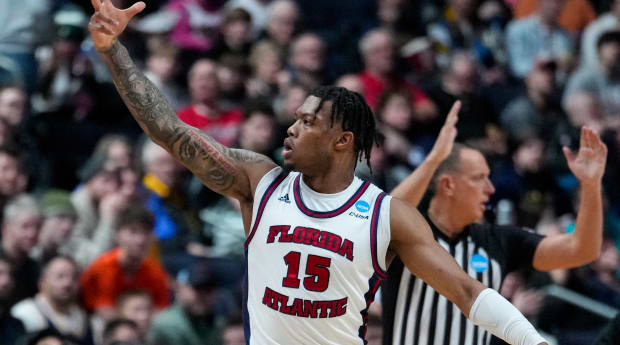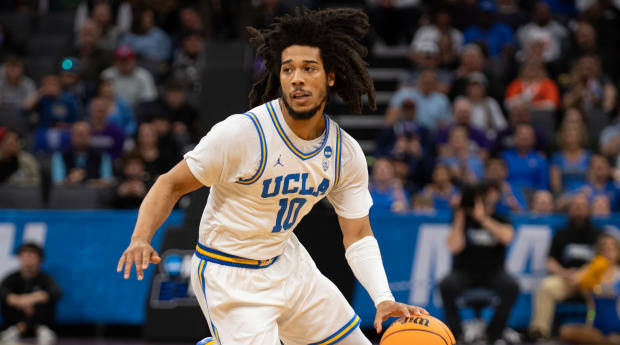After all the delightful tumult of the past four days, the NCAA tournament bracket has gotten a thorough scrubbing. As a result, we have arrived at a fresh-faced Sweet 16.
Welcome, Florida Atlantic. The Owls have never been here before and deserve to be celebrated, even if they did the dirty work of dispatching No. 16 seeded darling Fairleigh Dickinson.
Welcome back after an extended absence, Princeton. The Tigers were last seen in these parts in 1967, when the field consisted of 23 teams and they only had to win once to make the final 16.
Welcome to six new Sweet 16 coaches: Brian Dutcher of San Diego State; Mitch Henderson of Princeton; Danny Hurley of Connecticut; Dusty May of FAU; Jerome Tang of Kansas State; Rodney Terry of Texas.
Welcome to a new national champion, whoever it is. Reigning king Kansas was knocked out in the second round, marking the sixth straight tournament that the team that last won it all was gone before the next Sweet 16. Twelve of the 16 remaining teams have never won a natty, and seven of them have never made a Final Four.

Michael Conroy/AP
And unless Michigan State and Tom Izzo win the title, we will have a first-time championship coach cutting down the Final Four nets. Only six of the Sweet 16 coaches have advanced to the final weekend—Izzo, Tennessee’s Rick Barnes, UCLA’s Mick Cronin, Miami’s Jim Larranaga, Houston’s Kelvin Sampson and Gonzaga’s Mark Few. Of that contingent, Few and Cronin will be meeting in a regional semifinal knockout game, as will Sampson and Larranaga.
(And yes, we are all about another Gonzaga-UCLA NCAA tournament game. From the Jalen Suggs hero shot in 2021 to the Zags’ last-minute collapse that left Adam Morrison in tears in 2006, there’s some history there.)
On the whole, the remaining field is as diversely jumbled as the entire season has been.
There are 11 conferences represented, with none having more than three teams. This is a welcome development in an era when the power leagues continue to distance themselves from the masses in terms of money and resources. That diversity might shrink by the 2025 tournament, when the expansionist Big Ten, SEC and Big 12 inhale new members, but for now let’s celebrate having Conference USA in the Sweet Sixteen for the first time since 2009 (Memphis) and the Ivy League for the first time since 2010 (Cornell).
There are 13 states still in the mix, with none advancing more than two teams. We have no teams from the bedrock college hoops locales of North Carolina, Indiana or Kentucky still balling, but we do have New Jersey for the second straight year, Arkansas for the third straight, Tennessee and Nebraska. Plus two from Florida, which doesn’t happen often.
The Big East and SEC both advanced a trio of teams, while the widely acclaimed best league, the Big 12, has just two still playing. The Big Ten banner is being carried by only Michigan State, which is a familiar refrain for a conference that hasn’t won a national title since 2000. And the esteemed ACC was in danger of missing the Sweet 16 for the first time since 1979—by far the longest streak for any league—until Miami thumped Indiana on Sunday night.
In seeding terms, the No. 3s have fared the best so far, going 7–1. The only seeds that went winless were the No. 14s and the No. 12s—which often have been the most reliable upset perpetrators.
The average seed of the surviving teams is 4.9, making this a slightly more chalky tournament than many years due to the advance of just one double-digit seed. But having already lost a pair of No. 1s and a pair of No. 2s, the chances are strong for members of the bracket’s sprawling middle class to find their way to the Final Four.

José Luis Villegas/AP
The counterbalance to all the freshness that has survived and advanced is the presence of some really old players. Some we have seen on TV more often than our local TV anchors: Gonzaga’s Drew Timme; UCLA’s Tyger Campbell and Jaime Jaquez Jr.; Texas’s Marcus Carr; Tennessee’s Santiago Vescovi; Michigan State’s Joey Hauser; Miami’s Isaiah Wong; Alabama’s Jahvon Quinerly. Others might have gone unnoticed, but have been around for years: San Diego State’s Matt Bradley, Texas’s Timmy Allen and Kansas State’s Desi Sills are in the 150 College Game Club.
Assessing the bracket now after the wreckage of two rounds, Alabama not only remains the favorite but (by seeding) has the easiest path to the Final Four. The Crimson Tide’s competition in the South Region is No. 5 San Diego State, and then the winner of No. 6 Creighton and No. 15 Princeton. However, the Bluejays now look like the team they were supposed to be all season—and were, for intermittent stretches. They would come closest of anyone through four rounds to matching the Crimson Tide’s considerable talent.
In the East, it’s hard to even identify a favorite among No. 3 Kansas State, No. 4 Tennessee, No. 7 Michigan State and No. 9 FAU. Favor the Spartans on track record, I suppose. But the region also will have two of the under-the-radar stars of the first weekend: 5'8" K-State point guard Markquis Nowell (who dispatched Kentucky on Sunday with 27 points and nine dazzling assists); and FAU wing Johnell Davis, who had a Dwyane Wade-esque 29 points, 12 rebounds, five assists and five steals against FDU.
The Midwest Region is the most formful, with No. 1 Houston, No. 2 Texas, No. 3 Xavier and No. 5 Miami. All four teams flashed signs in the first two rounds of being Final Four caliber, and both semifinals should be high-level battles in Kansas City.
Likewise, there will be a lot of big-time players on the floor in Las Vegas when No. 8 Arkansas meets No. 4 Connecticut and No. 2 UCLA and No. 3 Gonzaga reunite. The Razorbacks could have the most talent and the least consistency of the four. UConn once again looks like the team that started the season 14–0 and whipped Alabama. The Bruins and Zags have been rocks of stable excellence for years with their current casts, both chasing an elusive national title.
Who will crash the Final Four? Who knows? But it’s a near certainty that some of the fresh faces in this Sweet 16 will still be dancing in Houston.
